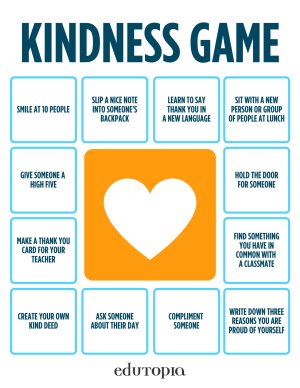Simple Ways to Encourage Kindness in Students of All Ages
With Random Acts of Kindness Day approaching, here are five easy ways to promote kindness across all age groups.
Your content has been saved!
Go to My Saved Content.Many teachers—in every grade from preschool to 12—are on the lookout for simple ways to promote social and emotional learning in school. Random Acts of Kindness Day, which is designated to encourage acts of generosity big and small, is an opportunity to do just that, and teachers may get a boost by letting students know that their peers in other countries have the same goal.
Here are five simple ways to bring both planned and totally random gestures of decency to your classroom on the day itself and well beyond.
1. Spread the Joy
Remind students that being kind doesn’t require grand gestures. This free printable bookmark encourages students to make kindness a priority, and it works for all ages. Younger students can color it in while older students can mark their place in their reading.
A kindness flyer is another simple way to engage students in middle school in compassionate acts. Elementary students can use this free template to design a tear-off poster that can be displayed in classrooms or hallways. Older students can make a similar flyer by brainstorming a list of kind actions and placing each on a tear-off portion of a flyer. Encourage students to take—and then actually do—the actions suggested by their classmates.
Grade levels: All
2. Gamify It
This bingo card from our archives can be printed and used to promote generous acts in the classroom. Students fill in each square when they take the specific action noted. The first person to fill the card wins.

A kindness scavenger hunt, like this one from Kiddie Matters, can help elementary school students look for ways to be nice to one another. Students complete as many actions as possible in a week. Teachers may choose to offer a prize for the student who completes the most or allow the gift of generosity to be the only prize.
Grade levels: K–5
3. Encourage Small Acts of Kindness
At John C. Haines Elementary School in Chicago, students place a pom-pom in a jar when they do something nice for their peers, and then describe the action to the class. Asking students to articulate their kindnesses and to work collaboratively to fill the jar reinforces a positive classroom culture. Once the jar is full, the entire class celebrates with a special treat or party.
Grade levels: pre-K–5
4. Go Digital
Leverage students’ excitement for apps to encourage kindness. The free app Nobly aims to “build a culture of kindness” as a platform for users to record and share their good deeds. The app connects kind acts through hashtags called “chains,” which allows students to see how their actions influence others to be kind.
Grade levels: 6–8, 9–12
5. Make It an Entire Month
A school in Cork, Ireland, Gaelscoil Mhichíl Uí Choileáin, replaces homework with acts of kindness for an entire month. Each day of the week has a theme: On Mondays, students communicate with an elderly person. On Tuesdays, they are tasked with helping their parents in some way. On Wednesdays, they find a random act of kindness to perform, and on Thursdays, they focus on self-care by doing something that makes them feel good about themselves. During the week students leave charitable observations of their peers in a “kindness bucket,” and at a Friday assembly, the school shares a few of the kind thoughts. Throughout the month, students document and reflect on their actions in gratitude diaries.
Grade levels: 6–8, 9–12
